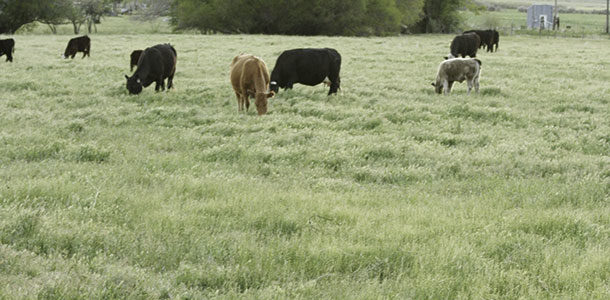3. Control grazing timing and intensity to meet plant community and livestock needs
4. Provide good plant and animal nutrition to maintain plant and animal health and performance
Plant growth varies over the year due to season and plant type (cool-season versus warm-season). Livestock nutritional demand varies over the animal production cycle (lactating versus dry cow).
Matching forage supply to livestock demand requires having one or more buffers in the grazing system.
Buffers include practices such as (but not limited to) timing the livestock production cycle to be in synch with forage production, varying the stocking rate over the year (selling yearlings midsummer or calves in the fall), producing hay from excess cool-season grass growth then grazing the aftermath forage produced on these acres, growing warm-season grasses to enhance summer forage supply and stockpiling feed for fall and winter grazing.
If buffers are not provided by management, they will be provided by nature. Nature’s buffers include wasting excess spring forage, overgrazing pastures in late summer and fall, reducing cow body condition in the fall – making it harder to overwinter cows and reducing their reproductive ability the following year – and reducing gain on growing cattle.
Soils differ across the landscape, and different plant communities will be best adapted to different soils. For example, creek- and river-bottom soils differ from the soils on hillsides and hilltops. Differences occur within each landscape position based on the underlying geology.
One creek bottom may consist of heavy, frequently flooded soil where grasses such as reed canarygrass are the best option. Another creek-bottom soil may be a deep, well-drained gravelly loam where sub-irrigated alfalfa-grass stands will flourish.
By fencing in tune with the landscape and its soils, we can manage for plant communities most adapted and productive in each soil environment. In many locations historical farming practices have already set up field borders along these lines since local experience found that soil differences affected crop management and production.
We manage for a desired plant community by controlling the timing and intensity of grazing. Timing of grazing will be based on the needed rest interval between grazing events. This can be measured as plant height or reproductive phase of the desired species.
Length of rest interval and intensity of defoliation are the main determinants of which plants will occur in a mixed plant community and the productivity of that community.
The length of time a paddock is grazed also affects grazing efficiency and plant regrowth vigor. When sizing paddocks for rotational grazing, size them based on herd size (pounds of grazing animals, not numbers of grazing animals) and the preferred length of grazing stay or occupation period.
A 14-day stay is not much better than continuous grazing. A seven-day stay removes the majority of spot grazing seen under continuous grazing and matches the needs of weekend farmers.
A three-day stay gives visibly more rapid regrowth than a seven-day stay, while a 12-hour stay is not only practical but is near ideal for the nutritional and management requirements of a dairy cow milked twice daily. How much leaf area is left at the end of grazing (grazing intensity) affects the plant community and animal performance.

When animals are first put into a paddock, they can selectively graze, allowing them to have high intake and performance. As they continue grazing the stand, they are less able to be selective, and pasture quality reduces intake and performance.
When the forage availability approaches 1,100 to 1,200 pounds of dry matter per acre (3 to 4 inches in height), forage mass limits bite size so much that intake drops greatly.
High-producing animals need to be able to selectively graze at a low grazing intensity in order to meet their nutritional needs. However, lower-producing animals can harvest a pasture more closely without harming animal performance.
Both plants and animals need proper nutrition in order to grow at their genetic potential. Many producers skimp on fertilizing pastures. However, fertilizing pastures is more cost-effective than fertilizing crops since the majority of nutrients are recycled back to soil through the animal’s manure and urine. This allows the plants and animals to use the applied nutrients year after year once the soil fertility is built up.
We need to lime the soil to the pH needed by the legume’s nitrogen-fixing bacteria. This is a minimum pH of 6 for clover and 6.5 for alfalfa. Other soil bacteria and soil organisms also do best when pH is in the 6 to 6.5 range.
The quantity and activity of these soil organisms determine soil health. Soil health improves water infiltration rate during rainfall events and the soil’s water-holding capacity for plant use between rainfall events.
Proper soil pH also provides good calcium and magnesium nutrition to the plants and animals, and optimum availability of many trace minerals for plants and animals.
Pasture plants respond to high soil test levels of phosphorus (P) and potassium (K). Legumes need phosphorus since nitrogen fixation is an energy-intensive process run by phosphorus in the plant. Legumes are not as competitive for potassium as are grasses, so if available potassium is in short supply, the legume content in the stand will likely decrease.
Legumes are important in pastures since they fix nitrogen from the air for use by all plants in the pasture. Orchardgrass pasture with red and white clover can produce as many pounds of yearling steer gain per acre as can orchardgrass pasture fertilized with 200 pounds of nitrogen per acre per year.
At current prices for nitrogen fertilizer, management for legumes in the stand is usually more cost-effective than applying nitrogen fertilizer.
Legumes are also important in pastures since they improve forage intake and animal production. As little as 25 to 30 percent legumes in a pasture increases weaned calf and yearling steer gain by 0.25 to 0.5 pounds per head per day and lactating dairy cow milk production by 6 to 10 pounds per head per day compared to the same pasture without legumes.
So where are you in your pasture management and where do you want to take your management in the future? Do you have adequate buffers in your system to balance forage supply to livestock demand?
Do your fences allow you to manage for the plants most adapted to the soil found in each paddock? Are you controlling the timing and intensity of grazing to meet the plant community and livestock needs?
Are you providing good soil fertility to provide plants with the nutrients they need for themselves and for the animals consuming the plants to optimize plant and animal health and performance? Attention to details, determination and perseverance will enable you to take your management to the level you desire. FG
PHOTO
What needs to be accomplished to step up grazing management depends on where management is and where the management team wants to go. A grazing system optimized for a given environment will achieve these goals: Photo courtesy of Progressive Forage staff.

-
Ed Rayburn
- Extension Forage Specialist
- West Virginia University
- Email Ed Rayburn











